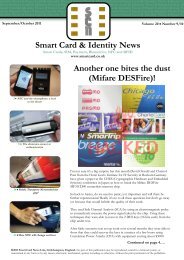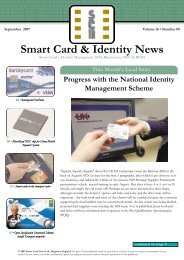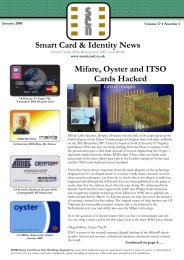Smart Card Identity News - Smart Card News
Smart Card Identity News - Smart Card News
Smart Card Identity News - Smart Card News
Create successful ePaper yourself
Turn your PDF publications into a flip-book with our unique Google optimized e-Paper software.
Fingerprinting, for example, is often associated with criminal behaviour, although the development of inkless<br />
fingerprinting removes some of this muddy taint. Members of some religious groups might not consent<br />
to a photograph of an unveiled face. Other people might wonder if there are health risks to iris scans (more<br />
accurate than fingerprints), and people with eye diseases might be excluded from being enrolled with this<br />
metric. Consequently, Accenture believes the future lies in multimodal biometrics, which consists in using a<br />
combination of several biometrics, depending on the application, individual and interaction channel. More<br />
in-depth study needs to be conducted to identify the most suitable biometrics for specific applications. No<br />
technology is 100% foolproof, which is why multimodal solutions are advisable, and why human intervention<br />
will be required in exceptional cases.<br />
For speed and efficiency, identity needs to be recorded in electronic format for automation and network<br />
based validation. Fortunately, content technologies enable the storage of biometrics data in digital format. In<br />
addition, Moore's law is still valid, and storage capacity and speed continue to race ahead at a remarkable<br />
pace. While the costs are relatively high now, they will come down with time and large-scale deployment. As<br />
businesses and governments head toward electronic solutions, it is important to keep in mind there needs to<br />
be a transition (i.e., backward compatibility) with paper. This can be achieved in the near term, for example,<br />
by travellers carrying a <strong>Smart</strong> <strong>Card</strong> version of a passport along with a traditional paper version. A likely success<br />
factor in biometric solutions is giving people a choice to opt-in for more advanced technologies and<br />
convenience. In Spain, the Baja Beach Club in Barcelona offers patrons a choice between a standard access<br />
card and a radio frequency identification (RFID) chip, about the size of a grain of rice, implanted under the<br />
skin of the triceps.<br />
A scanner reads the microchip and sends out a radio frequency signal. The chip enables patrons to jump the<br />
queue for club entrance and to have drink purchases tracked and paid for without carrying cash. Innovative<br />
biometrics applications in government and industry - Another example can be seen at Galp Energia, an oil<br />
and gas company formerly owned by the Portuguese government. Galp Energia set out to become the world's<br />
first petrol-station operator to install a thumbprint biometrics payment system. Accenture was part of the<br />
team that helped develop this solution. Within four months, customers who elected to join the scheme conducted<br />
transactions 75% faster and company performance has improved, as have customer satisfaction ratings.<br />
Additional biometric applications can be found in fleet management. International attacks on fuel-laden<br />
tankers have prompted security officials to include trucks on their lists of potential terrorist targets. To help<br />
prevent dangerous and costly incidents, Accenture has developed Transport Security Services, a prototype to<br />
provide security throughout a truck's journey from manufacturing plant to delivery point. Biometrics, in the<br />
form of fingerprint technology, are used to identify the driver before the truck door can be opened, thus<br />
ensuring that only authorized personnel can drive the truck. A large number of biometric trials and full-scale<br />
deployments are under way for national identity and specific government functions. They are proving that<br />
electronic ID schemes are feasible and deliver tangible benefits. For instance, the US-VISIT program, which<br />
is taking digital photographs and index finger scans of visitors at a number of US ports of entry, processed<br />
nearly 4 million foreign national applicants for admission in the first year.<br />
Since inception, US-VISIT has prevented 372 known criminals and visa violators from entering the country.<br />
While people tend to think first of public safety, identity systems with biometrics will provide a wide range<br />
of advantages for individuals, businesses and governments. Citizens and businesses stand to face a reduced<br />
risk of identity theft. They will also benefit from greater convenience in access to services and benefits, which<br />
will be made easier for honest citizens and more difficult for those who aren't. In terms of government operations,<br />
citizens can expect to see more efficient use of tax money, with better detection of fraud and more<br />
accurate control of service and benefits.<br />
Industry Insight<br />
The future of identity, after all, is not only to keep the wolves from the door, but to deliver innovative, high<br />
performance solutions that efficiently speed the delivery of products and services to trusted individuals.<br />
www.accenture.com<br />
12<br />
<strong>Smart</strong> <strong>Card</strong> & <strong>Identity</strong> <strong>News</strong> • July 2007
















